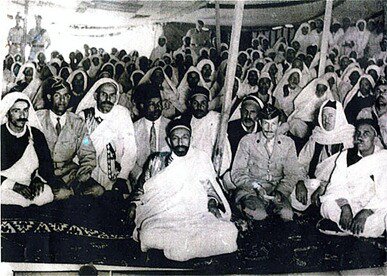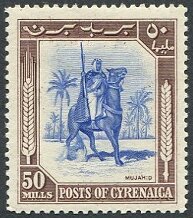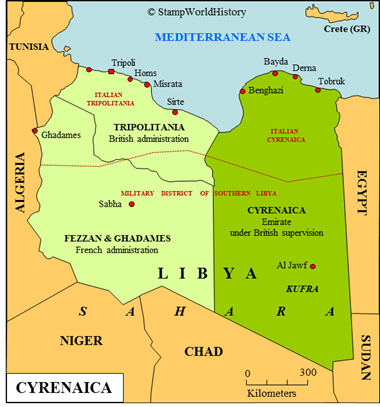برقة

Cyrenaica
Quick reference
General issues: Emirate 1950-1951
Country name on general issues: Cyrenaica
Currency: 1 Pound = 1000 Millièmes 1950-1951
Population: 291 000 in 1954
Political history Cyrenaica
Cyrenaica is located in northern Africa in the current Libya. In the 19th century Cyrenaica is part of the Ottoman Empire. After the Italo-Turkish war, Italy, in 1912, takes possession of Cyrenaica. Cyrenaica will come to be administered as the colony of Italian Cyrenaica. It will take more then two decades, though, before Italy establishes effective rule over Cyrenaica. Cyrenaica is a stronghold of the Senussi leadership. The Senussi are, in origin, a religious order that has ascended to worldly power in large parts of Libya – including Cyrenaica. When, during WWI, Italy redirects its armed forces from Libya to the European theaters of war, the Senussi leadership de facto takes control of Cyrenaica – the Italians being forced back to the coastal towns.
After WWI, Italy initially tries to establish control in Lybia by appeasing the local leaders. Mohammed Idris el-Senussi – the Senussi leader of the time – is granted the title of emir and self government in the Kufra region south of Italian Cyrenaica. From 1922, Italy changes it course – prior agreements are abrogated and Libya is brought under Italian control by military force. Idris goes into exile in Egypt in 1923 and most of Italian Cyrenaica is brought under effective Italian rule between 1926 and 1928. The Senussi, however, continue a guerrilla war from the Kufra region until they are ultimately defeated in 1931.

1944 – Muhammed Idris el-Senussi having returned to Cyrenaica meets with the Cyrenaica dignitaries to renew the pledges of allegiance.
During WWII, Libya is one of the major theaters of war. Changing fortunes eventually lead to Allied victory and by 1943 the Italians are driven out of Libya. The French and the British divide Libya into three occupation zones: Cyrenaica and Tripolitania administered by the British and Fezzan & Ghadames administered by the French. The borders of these zones are different from the borders of the Italian period. Most notably the territory of Ghadames – part of the former Italian Tripolitania – becomes part of Fezzan & Ghadames and the Kufra region south of the former Italian Cyrenaica is attached to the Cyrenaica zone. The British set up separate military administrations for Tripolitania and Cyrenaica to accommodate for differences in the local and international political context of the territories.
With support of the British administration, Idris el-Senussi returns to Cyrenaica. In the years directly after WWII, different options for the future of Libya are on the table – ranging from a division of Libya to the establishment of a unified state. To secure his position, in 1949 Idris, with British support, proclaims the independent emirate of Cyrenaica. Though independence de jure does not gain international recognition, the British de facto transfer much of the administration of Cyrenaica to the emir.
The future of Libya is finally decided when, in 1949, the United Nations step in. A resolution is passed stating that Libya is to gain independence as a unified state by 1952. Events subsequently develop in such a way that Idris is crowned king of the independent kingdom of Libya in 1951.
Postal history Cyrenaica

1950 – A Senussi mujahid – warrior. The use of the term ‘mujahid’ – please note the inscription at the bottom of the stamp – suggests that the wars fought by the Senussi had strong religious connotations – in line with the religious origin of the Senussi order.
The first stamps used in Cyrenaica are the issues of the Ottoman Empire – these to be superseded by the issues of Italian Libya and Italian Cyrenaica. During the period of British administration, stamps issued by the British are used – from 1943 the stamps issued for the Middle East Forces and from 1948 the issues for Tripolitania that are also used in Cyrenaica. These are, in 1950, superseded by the stamps issued by the emirate of Cyrenaica. One set of postage stamps is issued – a nicely engraved design printed by Waterlow in London. The stamps of the emirate from 1951 are superseded by the issues of the independent kingdom of Libya.
Album pages
← Previous page: Congo (Kinshasa)Next page: Dahomey →


